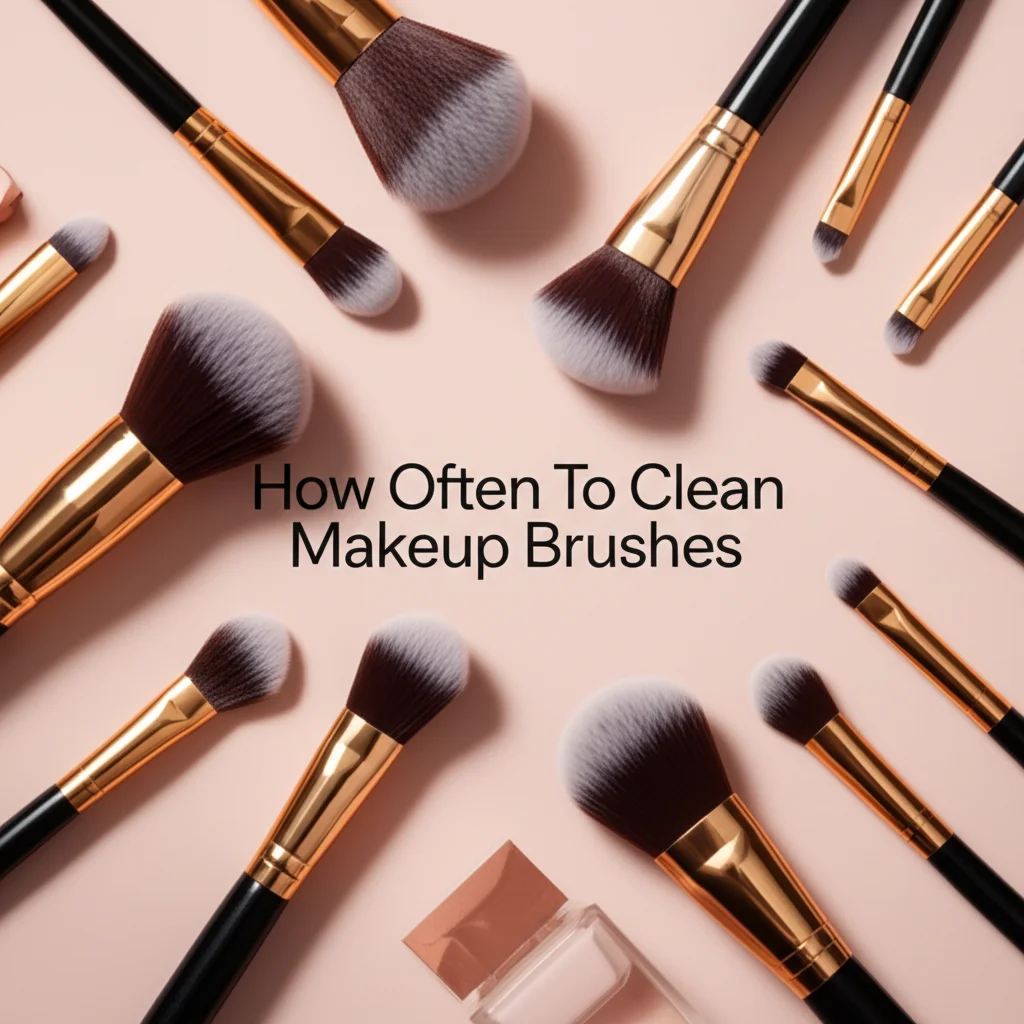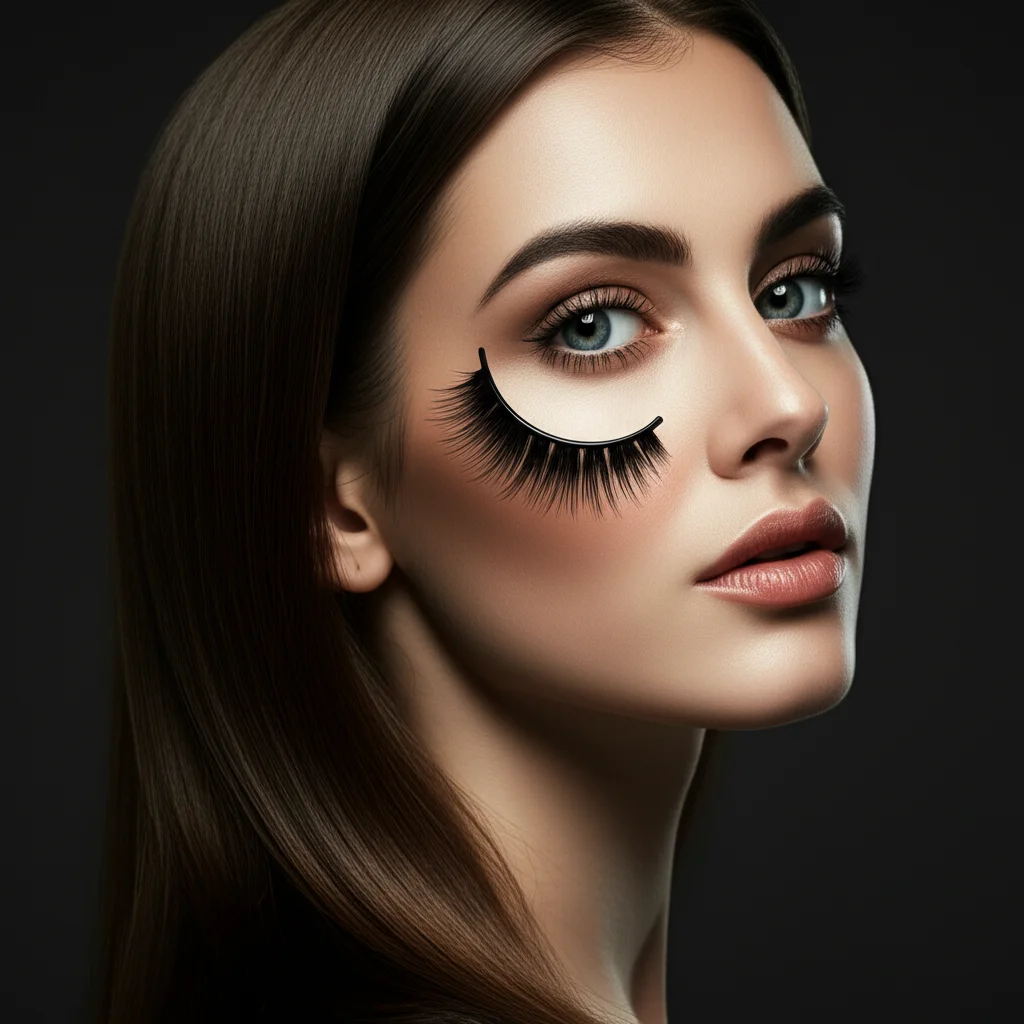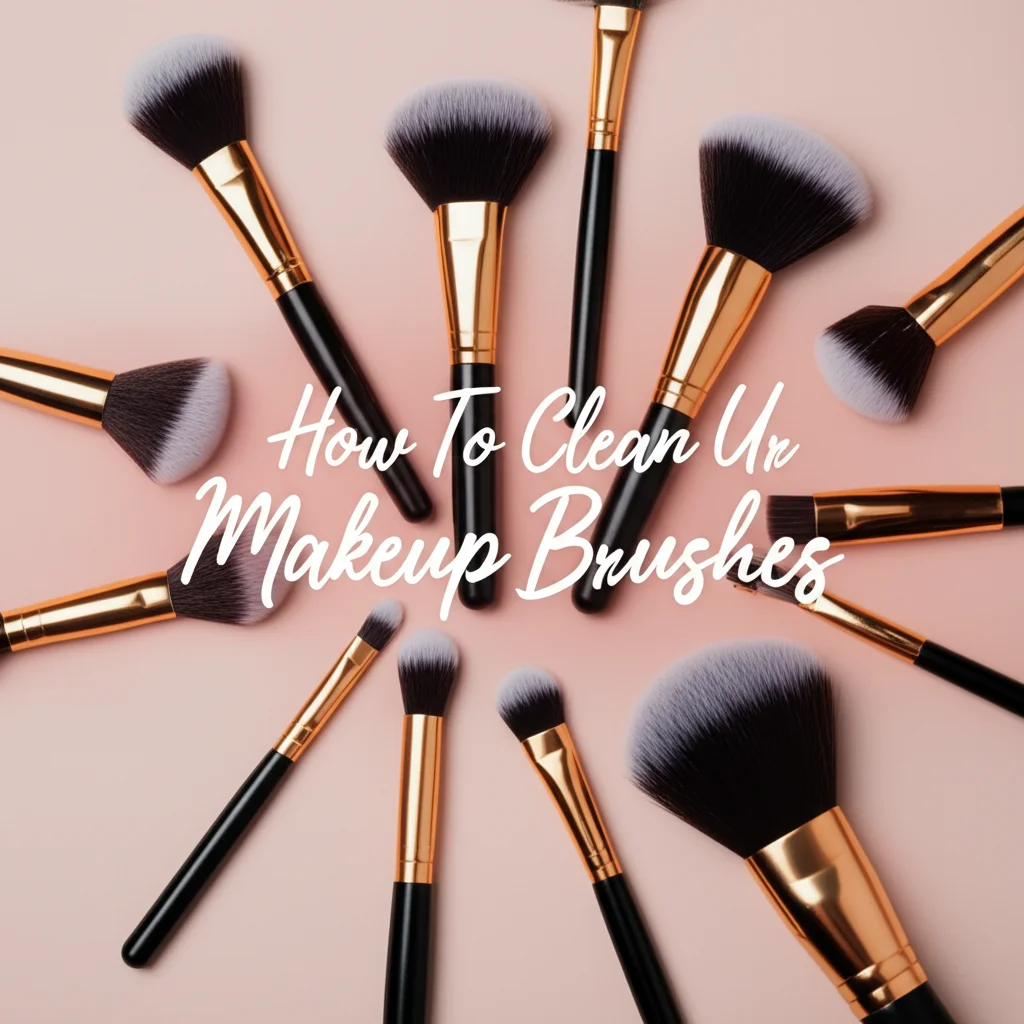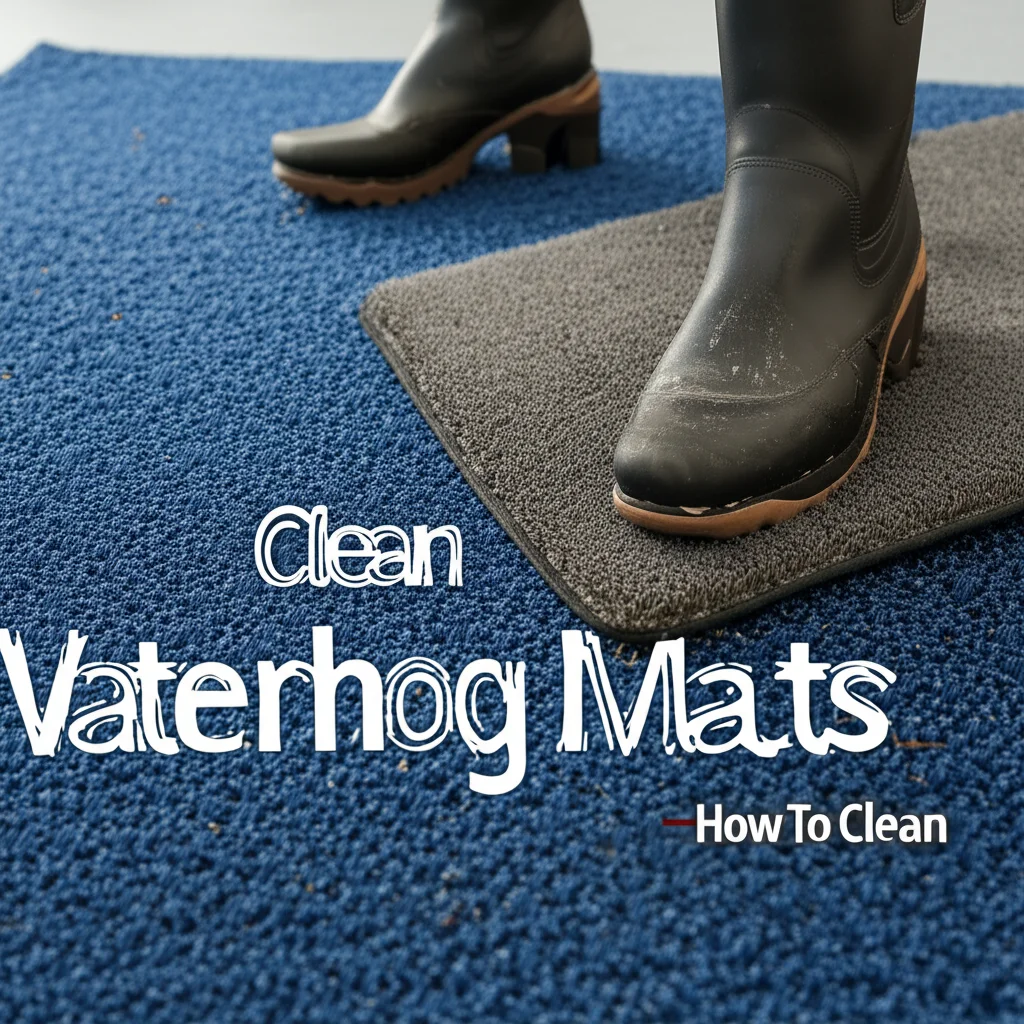· Todd Martin · Beauty · 15 min read
How Often To Clean Makeup Brushes

How Often to Clean Makeup Brushes: Your Essential Guide
Ever wondered what’s truly lurking on your favorite makeup brushes? Many of us use these tools daily without a second thought. But ignoring their cleanliness can harm your skin and spoil your makeup application. Learning how often to clean makeup brushes protects your skin and keeps your makeup looking its best.
Dirty brushes collect old makeup, dead skin cells, oil, and bacteria. This mix can lead to skin problems like breakouts or irritation. Clean brushes help makeup apply smoothly and evenly. This guide will show you exactly how often to clean your brushes based on their use. We will also share the best cleaning methods and tips for proper brush care.
Takeaway
- Foundation/Concealer Brushes: Clean after every 1-2 uses.
- Eye Brushes (Liquid/Cream): Clean after every use.
- Powder Brushes (Blush, Bronzer): Clean once a week.
- Eyeshadow Brushes (Powder): Clean once a week or more for different colors.
- Spot Clean: Daily for quick touch-ups.
- Deep Clean: Weekly or bi-weekly for thorough hygiene.
Makeup brushes need regular cleaning. For brushes used with liquid or cream products, clean them after every 1-2 uses. Brushes for powder products need cleaning at least once a week. This routine removes makeup buildup, oils, and bacteria, protecting your skin and ensuring smooth product application.
Why Cleaning Makeup Brushes Matters for Your Skin and Application
Using dirty makeup brushes can cause serious problems for your skin. Each time you use a brush, it picks up oil, dead skin cells, and old makeup. Over time, these brushes become a breeding ground for bacteria. When you apply makeup with a dirty brush, you transfer these germs directly onto your face.
This transfer leads to skin issues like breakouts, acne, and even infections. Your skin can become irritated or inflamed. Dirty brushes also hurt your makeup application. They make makeup look streaky or muddy.
- Prevents Skin Problems: Regular cleaning removes bacteria and prevents acne breakouts. It keeps your pores clear. This helps maintain healthy skin.
- Improves Makeup Application: Clean bristles pick up product better and apply it smoothly. Your foundation will look even. Your eyeshadow colors will blend well.
- Extends Brush Life: Dirt and product buildup can damage brush bristles. Cleaning them regularly keeps them soft and functional. It helps your brushes last longer.
- Reduces Product Waste: Clean brushes use less product. They deposit makeup efficiently onto your face. You get more use from your makeup items.
Dirty brushes cannot blend makeup properly. You might find your foundation looks patchy or your blush appears uneven. Clean brushes allow for precise and smooth application. This makes your makeup look professional every time. Regularly cleaning your brushes is a key step in a good skincare routine.
Decoding the Frequency: How Often to Clean Different Makeup Brushes
The ideal cleaning schedule for your makeup brushes depends on their type and how often you use them. Some brushes need cleaning more often than others. Understanding these differences helps maintain proper hygiene. It also ensures your makeup looks fresh.
Here is a breakdown for various brush types:
Liquid and Cream Product Brushes (Foundation, Concealer):
- These brushes touch moist products.
- Moisture creates a perfect environment for bacteria to grow quickly.
- You should clean these brushes after every 1-2 uses.
- This prevents bacteria transfer and ensures smooth application.
Powder Product Brushes (Blush, Bronzer, Finishing Powder):
- These brushes handle dry products.
- They collect less moisture and fewer germs than liquid brushes.
- A good schedule is to clean them once a week.
- This keeps them free of old product and oils.
Eyeshadow Brushes (Powder):
- Eyeshadow brushes come in contact with a sensitive area: your eyes.
- Clean them at least once a week.
- If you use different colors for different looks, consider cleaning them more often. This prevents color mixing.
- For specific guidance, learn how to clean eyeshadow brushes effectively.
Eyeliner and Eyebrow Brushes:
- These brushes are usually small and precise.
- They often use gel or cream products.
- Clean them after every use or every other use.
- This is crucial for preventing eye infections.
Understanding these frequencies helps you manage your brush cleaning routine. For a general guide on keeping all your tools clean, you can also refer to broader articles like how to clean makeup brush or how to clean your makeup brushes. These resources provide comprehensive steps for maintaining your entire brush collection.
Spot Cleaning vs. Deep Cleaning Makeup Brushes: Know the Difference
Cleaning makeup brushes involves two main methods: spot cleaning and deep cleaning. Each method serves a different purpose. Knowing when to use which method is key to maintaining brush hygiene effectively. Both are important for keeping your brushes clean and your skin healthy.
Spot Cleaning: Spot cleaning is a quick way to clean brushes between deep washes. It removes surface makeup and sanitizes the bristles instantly. You do not need to wait for the brushes to dry completely after spot cleaning. This makes it ideal for daily use.
- Purpose: To quickly sanitize and remove the top layer of makeup. It is for daily maintenance.
- Method: Use a quick-drying brush cleaning spray or a liquid cleaner on a tissue. Swirl the brush on the tissue until no more color comes off.
- Frequency: Use daily, especially for brushes used with liquid products. This is great for refreshing brushes between makeup applications.
- Benefits: Keeps brushes ready for immediate use. It extends the time between deep cleans.
Deep Cleaning: Deep cleaning involves thoroughly washing brushes with soap and water. This method removes all layers of product, oil, dead skin, and bacteria from the bristles. It takes more time because the brushes need to dry completely. Deep cleaning is essential for proper brush hygiene.
- Purpose: To remove accumulated dirt, oil, and bacteria from deep within the bristles. It is for thorough sanitation.
- Method: Use a gentle soap or brush shampoo and water. Lather the brush, rinse it thoroughly, and reshape the bristles. Lay flat to dry.
- Frequency: Perform a deep clean once a week for frequently used brushes. For less used brushes, clean them bi-weekly or monthly.
- Benefits: Ensures maximum cleanliness and hygiene. It prevents skin breakouts and keeps brushes soft.
Both spot cleaning and deep cleaning play vital roles in makeup brush maintenance. Spot cleaning offers daily convenience, while deep cleaning provides essential sanitation. Combining these methods ensures your brushes are always clean and ready for use. This dual approach helps prolong the life of your brushes. It also protects your skin from harmful bacteria.
Your Step-by-Step Guide to Deep Cleaning Makeup Brushes
Deep cleaning your makeup brushes is a simple process. It needs a little time, but it brings great benefits. A thorough wash removes all dirt and bacteria. This keeps your skin clear and your makeup looking flawless. Follow these steps for a complete deep clean.
Wet the Bristles:
- Hold your brush bristles facing down under lukewarm running water.
- Avoid getting water inside the ferrule, which is the metal part connecting bristles to the handle. Water inside can loosen the glue.
Apply Cleaner:
- Pour a small amount of brush cleanser or gentle soap onto your palm or a cleaning mat. Baby shampoo works well as a gentle option.
- You can also use specialized brush cleaning products. For a general guide on cleaning various tools, consider checking out articles like how to clean makeup sponges and brushes for broader cleaning techniques.
Lather and Swirl:
- Gently swirl the brush bristles in the cleanser on your palm or mat.
- Move the brush in small circles. You will see makeup residue come out.
- Continue until the lather looks clean.
Rinse Thoroughly:
- Hold the brush under lukewarm running water again, bristles down.
- Rinse until no soap suds or makeup residue remains.
- The water running off the brush should be clear.
Reshape and Squeeze:
- Gently squeeze excess water from the bristles.
- Use your fingers to reshape the brush head to its original form. This prevents bristles from splaying out when dry.
Lay Flat to Dry:
- Place your clean brushes on a clean towel or a brush drying rack.
- Ensure the bristles hang off the edge or point downwards if using a rack. This allows air circulation and prevents water from seeping into the ferrule.
- Do not stand brushes upright to dry. Water can collect in the ferrule, which damages the brush.
Allow Complete Drying:
- Let brushes air dry completely before using them again. This can take several hours or overnight.
- Make sure they are fully dry to prevent mold growth.
Following these steps ensures your brushes are truly clean. They will be safe to use on your skin. Regular deep cleaning extends the life of your brushes and keeps them performing at their best.
Choosing the Right Cleaning Solutions for Your Makeup Brushes
Selecting the correct cleaning solution is essential for effectively cleaning your makeup brushes without causing damage. Different solutions work for various brush types and cleaning needs. It is important to choose products that are both powerful enough to remove makeup and gentle enough for the brush bristles.
Commercial Brush Cleansers: Many beauty brands offer specialized makeup brush cleansers. These products are designed to break down makeup, oils, and bacteria. They are often quick-drying and safe for all brush types.
- Pros: Formulated specifically for brushes, often sanitize, many dry quickly.
- Cons: Can be more expensive than household alternatives.
- Use: Follow product instructions, usually squirt onto bristles or a cleaning pad.
Gentle Soaps and Shampoos: You can use common household items as effective brush cleaners. Baby shampoo is a popular choice. It is mild and contains fewer harsh chemicals. Dish soap can also work for stubborn oil-based makeup.
- Baby Shampoo: Very gentle, good for natural and synthetic bristles. It cleans well without stripping the bristles.
- Dish Soap: Excellent for oil-based foundation and stubborn makeup. Use sparingly and rinse very well to avoid residue.
- Use: Lather a small amount with water. Swirl the brush gently.
Alternative Cleaning Methods: Some people prefer using common household products like vinegar or alcohol for deep cleaning or sanitizing. These methods can be effective but require careful use to avoid damaging brush bristles or handles.
- Vinegar: A diluted vinegar solution can deep clean and sanitize brushes. Mix white vinegar with water (1 part vinegar to 2 parts water). Swirl brushes in the mixture, then rinse thoroughly. For a full guide on this method, read how to clean makeup brushes with vinegar. Always rinse well to remove the vinegar smell.
- Alcohol: Isopropyl alcohol acts as a strong disinfectant. It also helps break down makeup. Use a spray bottle with 70% isopropyl alcohol for spot cleaning or dip brushes briefly. Make sure you understand how to clean makeup brushes with alcohol safely before trying. Alcohol can dry out natural bristles, so use it sparingly and with caution.
Always test any new cleaning solution on a small, less-used part of a brush first. This helps ensure it does not cause damage. No matter what solution you choose, thorough rinsing is key. This removes all cleaner residue and leaves your brushes truly clean.
Clear Signs Your Makeup Brushes Demand Immediate Cleaning
Sometimes, your brushes send clear signals that they need attention. Recognizing these signs helps you avoid applying makeup with dirty tools. It ensures your skin remains healthy. Pay close attention to how your brushes look, feel, and perform. These indicators tell you when it is time for a wash.
Visible Makeup Buildup:
- You can see old foundation or eyeshadow caked on the bristles.
- The brush color is no longer true to its original shade.
- This indicates heavy product accumulation. It makes applying new makeup difficult.
Stiff or Clumpy Bristles:
- Clean brush bristles feel soft and move freely.
- Dirty brushes feel stiff, hard, or clumpy.
- Product buildup glues the bristles together. This makes blending impossible.
Streaky or Uneven Makeup Application:
- Your foundation looks patchy. Your blush applies in harsh lines.
- Dirty brushes cannot distribute product evenly. They leave marks.
- If your makeup suddenly looks off, your brushes are likely the cause.
Odor:
- Dirty brushes can develop an unpleasant smell.
- This odor comes from bacteria and old product decaying.
- A bad smell is a strong indicator of bacterial growth. This means immediate cleaning is necessary.
Skin Breakouts or Irritation:
- You notice new pimples, redness, or itchy skin after applying makeup.
- Dirty brushes transfer bacteria and irritants to your skin.
- If your skin health declines, consider your brush hygiene.
Color Transfer:
- Using an eyeshadow brush with a new color, but the old color shows through.
- This means residual pigment is still on the bristles.
- The brush needs a wash to ensure pure color application.
Paying attention to these signs will keep your brushes performing at their peak. It also helps protect your skin from unnecessary exposure to bacteria and buildup. If you notice any of these signs, put cleaning your brushes at the top of your to-do list.
Best Practices for Makeup Brush Care and Storage
Cleaning your makeup brushes is only half the battle. Proper care and storage ensure they last longer. It also keeps them hygienic between washes. Good habits can protect your investment and maintain skin health. Here are essential tips for caring for your makeup brushes.
Thorough Drying is Crucial:
- Always allow brushes to dry completely after cleaning.
- Lay them flat on a clean towel or use a brush drying rack.
- Make sure bristles hang off the edge or face downwards. This stops water from seeping into the ferrule. Water trapped in the ferrule can loosen glue and cause bristles to fall out. It also prevents mold growth.
Reshape Bristles While Wet:
- After rinsing and squeezing excess water, gently reshape the brush head.
- This helps the brush maintain its original form. It keeps bristles from splaying out as they dry. A well-shaped brush performs better.
Store Brushes Properly:
- Once dry, store brushes upright in a cup or brush holder.
- Keep them in a clean, dry place away from dust and direct sunlight.
- Consider using a brush roll or bag for travel. This protects them from damage and dirt.
- For advice on keeping your entire beauty setup clean, learn how to clean a makeup bag and other accessories.
Avoid Sharing Brushes:
- Sharing makeup brushes can transfer bacteria, viruses, and skin issues.
- Each person should have their own set of brushes.
- This is especially important for eye and lip brushes.
Regular Spot Cleaning:
- Use a quick-drying spray cleanser daily or after each use for brushes handling liquid products.
- This removes surface makeup and helps reduce bacterial buildup between deep cleans.
- It keeps brushes fresh and ready for your next application.
Inspect Brushes Regularly:
- Check your brushes for signs of wear and tear.
- Look for shedding bristles or handles coming loose.
- Proper care extends brush life, but brushes do not last forever.
By following these best practices, you ensure your makeup brushes stay in excellent condition. They will perform optimally for a long time. These simple steps contribute to cleaner makeup application and healthier skin.
FAQ Section
Q1: Can I use dish soap to clean makeup brushes? Yes, you can use a small amount of mild dish soap for makeup brushes, especially for those with heavy, oily makeup buildup like foundation. Dish soap is very effective at cutting through oil. However, it can be drying. Always dilute it with water and rinse your brushes very thoroughly afterward to prevent any residue from irritating your skin or damaging the bristles.
Q2: How often should I replace makeup brushes? Makeup brushes do not have a strict expiration date like makeup products. With good care, quality brushes can last for years. However, replace them if bristles start shedding excessively, become splayed and lose their shape, or if they develop a persistent odor that won’t wash out. These signs indicate the brush is no longer performing well or is unhygienic.
Q3: What happens if I don’t clean my makeup brushes? Not cleaning your makeup brushes can lead to several problems. Dirty brushes accumulate old makeup, dead skin cells, oils, and bacteria, which can cause skin irritation, breakouts, and infections. They also affect makeup application, making products appear streaky, uneven, or muddy. Over time, dirty brushes can also become stiff and damaged.
Q4: How long do makeup brushes take to dry? The drying time for makeup brushes varies. It depends on the brush size, bristle density, and humidity. Most brushes take between 4 to 8 hours to dry completely. Larger, denser brushes like foundation or powder brushes may take up to 24 hours. Always ensure brushes are fully dry before storage or use to prevent mold and bacterial growth.
Q5: Can cleaning makeup brushes cause damage? Improper cleaning methods can damage makeup brushes. Using very hot water can melt the glue in the ferrule, causing bristles to shed. Harsh soaps or vigorous scrubbing can also damage delicate bristles. Always use lukewarm water and gentle cleansers. Be gentle when swirling and rinsing. Proper drying, like laying brushes flat, also prevents damage.
Conclusion
Keeping your makeup brushes clean is a simple yet powerful habit. It protects your skin, enhances your makeup application, and extends the life of your valuable tools. You now understand how often to clean makeup brushes, differentiating between various types and cleaning methods. From daily spot cleaning to weekly deep cleans, each step plays a vital role in maintaining optimal hygiene.
Remember, brushes used with liquid products need cleaning more often than those used with powders. Pay attention to the signs your brushes give you—stiffness, odor, or poor application—as these are clear calls for a wash. By following the detailed cleaning steps and best care practices, you ensure your brushes remain soft, effective, and free from harmful bacteria. Make regular brush cleaning a consistent part of your beauty routine. Your skin will thank you, and your makeup will look more flawless than ever. Embrace these habits for a cleaner, healthier beauty regimen.





